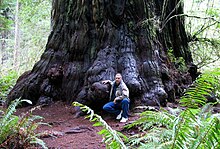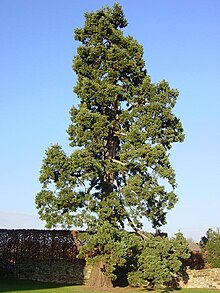Arbor




Arbor (-is, f.) est planta perennis lignea, plerumque definita cui sunt multi rami secundi supra solum in singulo cauli vel trunco principali sustentati, cum certa dominatione apicali.[1] Nonnulli auctores minimam arboris maturae altitudinem postulant, quae a 3 m[2] ad 6 m[3] variat; nonnulli autem diametrum trunci minimum 10 centimetrorum postulant (30 cm circumferentia).[4] Planta lignea quae has definitiones non attingit frutex usitate appellatur, quamquam multae arbores, quales arbores habitus mallee appellati, has definitiones non attingunt. Contra plurimas plantas alias, arbores diu vivunt, et nonnullae nonnullorum milium annorum aetatem et altitudinem 115 m adsequuntur.[5]
Multi arbores fructus pariunt. Multitudo arborum "nemus," "silva," aut "silvula" appellatur; homo qui in silvis habitat, silvicola.
Folium arboris oxygenium et saccharum luce solis ex dioxido carbonis et aqua generat.
Species
[recensere | fontem recensere]Genera speciesque arborum sunt multae; inter arbores notissimas sunt:
- Abies
- Abies alba
- Abies pinsapo
- Acer
- Acer campestre
- Acer negundo
- Acer platanoides
- Acer pseudoplatanus
- Acer tataricum
- Beilschmiedia
- Beilschmiedia tarairi
- Beilschmiedia tawa
- Betula
- Betula nana
- Betula pendula
- Carpinus
- Carpinus betulus
- Fagus
- Fagus sylvatica
- Liriodendron
- Liriodendron tulipifera
- Malus
- Metasequoia
- Metasequoia glyptostroboides
- Nothofagus
- Nothofagus fusca
- Olea
- Olea europaea
- Picea
- Picea abies
- Pinus
- Pinus nigra
- Pinus pinea
- Pinus sylvestris
- Platanus
- Platanus orientalis
- Prunus
- Prunus avium
- Prunus cerasus
- Prunus dulcis
- Prunus persica
- Punica malus
- Quercus
- Quercus cerris
- Quercus frainetto
- Quercus petraea
- Quercus pubescens
- Quercus robur
- Quercus rubra
- Sequoiodendron
- Sequoiodendron giganteum
- Sorbus
- Taxodium
- Taxodium distichum
- Taxus
- Taxus baccata
Arbores in Bibliis
[recensere | fontem recensere]Arbores saepe in Bibliis commemorantur; notabiles sunt duae in paradiso Eden, horto a Deo creato:
Nexus interni
- Ann Arbor (urbs)
- Anulus annuus
- Arbor felix (urbs)
- Arbores Novae Zelandiae
- Arboretum
- Dendrochronologia
- Ent
- Frutex
- Lignum
- The Lorax
- Radix (botanica)
- Ramus (arbor)
- Systema naturae
Notae
[recensere | fontem recensere]- ↑ Huxley, A., ed. (1992). New RHS Dictionary of Gardening. Macmillan ISBN 0-333-47494-5.
- ↑ Rushforth, K. (1999). Trees of Britain and Europe. Collins ISBN 0-00-220013-9.
- ↑ Mitchell, A. F. (1974). A Field Guide to the Trees of Britain and Northern Europe. Collins ISBN 0-00-212035-6
- ↑ Utkarsh Ghate. "Field Guide to Indian Trees, introductory chapter: Introduction to Common Indian Trees" (RTF)
- ↑ Gymnosperm Database: Sequoia sempervirens
Bibliographia
[recensere | fontem recensere]- Pakenham, T. 1996. Meetings with Remarkable Trees. ISBN 0-297-83255-7.
- Pakenham, T. 2002. Remarkable Trees of the World. ISBN 0-297-84300-1.
- Tudge, C. 2005. The Secret Life of Trees: How They Live and Why They Matter. Londinii: Allen Lane. ISBN 0-7139-9698-6.
- Wohlleben, Peter, Tim F. Flannery, S. Simard, et Jane Billinghurst. 2016. The Hidden Life of Trees: What They Feel, How They Communicate: Discoveries from a Secret World. ISBN 978-1-77164-248-4. OCLC 933722592.
Nexus externi
[recensere | fontem recensere]| Vicimedia Communia plura habent quae ad arbores spectant. |
- "Oaks in Bialovieza," apud situm deby.bialowieza.pl
- 770 paginae breve descriptae apud zeal.com
- "USDA National Resources Conservation Service - Plants Database," apud situm plants.usda.gov
Text is available under the CC BY-SA 4.0 license; additional terms may apply.
Images, videos and audio are available under their respective licenses.
